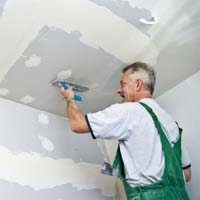Dusty Job May Raise the Risk of Mesothelioma
 A new study on drywall sanding finds that people who do it – from specialists to do-it-yourselfers – could be exposed to asbestos fibers in excess of current safe limits.
A new study on drywall sanding finds that people who do it – from specialists to do-it-yourselfers – could be exposed to asbestos fibers in excess of current safe limits.
Until the mid-1970s, the compound used to seal up the joints between wall boards contained chrysotile asbestos, a mineral designed to increase strength and durability and to minimize fire risk. However, many people are now suffering the effects of earlier exposures and others are still being exposed by working in older buildings.
In an effort to quantify the risks, researchers with ENVIRON International Corporation in Chicago collected information about drywall dust exposures by surveying experienced contractors, visiting job sites, and reviewing other studies on the subject. They then applied mathematical models to come up with “personal breathing zone respirable dust concentrations” for various groups of drywall workers. The higher the concentration of asbestos-containing dust, the greater the likelihood that a worker might develop mesothelioma or lung cancer.
Not surprisingly, drywall specialists were found to be at greatest risk of mesothelioma and other lung conditions because of asbestos dust exposure. Generalists who also do drywall work had the second highest risk based on dust concentrations, followed by DIYers and bystander tradespersons.
“These concentrations are estimated to be in excess of the respective current but not historical Threshold Limit Values,” writes author Fred Boelter in the journal Risk Analysis. This means that, even though past workers may not have been exposed to asbestos levels that were considered high at the time they did the work, the amount they inhaled might still be high enough to pose a mesothelioma risk by today’s standards.
While the study concludes that the cumulative exposure from drywall sanding is probably unlikely to cause many mesothelioma deaths, given the dustiness of the job, the authors recommend “diligence in the use of readily available source controls” in order to continue to minimize the risks.
As more people attempt to do their own home repairs and remodeling to save money, the risk of encountering toxic asbestos increases. The risk of mesothelioma among DIYers has become such a concern in Australia that the Australian government has launched a multi-million dollar advertising campaign to warn people of the dangers. In the US, owners of older homes are advised to contact an asbestos abatement professional before attempting to do their own home repairs or remodeling.
Source:
Boelter, FW, “Comparative Risks of Cancer from Drywall Finishing Based on Stachastic Modeling of Cumulative Exposure to Respirable Dusts and Chrysotile Asbestos Fibers”, November 25, 2014, Risk Analysis, Epub ahead of print.





